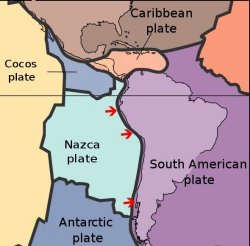
November Editorial
Rock mass might have altered earthquake effect

November Editorial
Rock mass might have altered earthquake effect
|
|
On Saturday, 27th of February 2010, Chile was hit by a massive earthquake which registered a magnitude of 8.8 on the Moment Magnitude Scale. (This scale is used by seismologists to measure the power of earthquakes in terms of energy released.) The earthquake lasted for about 3 minutes and it was felt strongly by a majority of Chileans. Tremors were also felt in many cities in Argentina and as far north as Ica city in southern Peru. Indeed, we now know that the 2010 Chilean earthquake was the sixth largest earthquake ever to be recorded by a seismograph. |
Chile is located on the Pacific Ring of Fire where the subduction of tectonic plates generates many of the world's largest earthquakes (and the volcanoes, which give the ring its name). The 2010 quake was caused by the subduction of a particular tectonic plate, the Nazca plate, beneath the South American Plates. Because of its location, the quake was not completely unexpected, and partly as a consequence, the Chilean is one of the best-recorded earthquakes ever. This has given seismologists an unprecedented opportunity to study the ruptures of mega-quakes in detail.
The most recent of such studies is from the University of Liverpool in the UK. This has revealed a large mass of rock which lies deep in the active fault line beneath Chile. This large geological structure was discovered when analyzing the 3-D seismic images.The researchers created a 3-D velocity model of the rupture zone by manually analyzing aftershocks from onshore seismic stations and ocean bottom seismometers and overlying it with local earthquake tomography.
This newly discovered rock mass was shown to be unusually dense and large for something at this depth within the Earth's crust. The scientists believe that the rock is of an ultramafic composition, possibly related to extension and a mantle upwelling during the Triassic period, some 220 million years ago.
One interesting thing about this large mass of rock is that it may have directly influenced the earthquake by slowing down the movement of the plates. As Stephen Hicks from the School of Environmental Sciences, and the lead author in this study points out: "It was previously thought that dense geological bodies in an active fault zone may cause more movement of the fault during an earthquake…..However, our research suggests that these blocks of rock may in fact cause the earthquake rupture to suddenly slow down. But this slowing down can generate stronger shaking at the surface, which is more damaging to human-made structures."
The scientists are planning to expand their research into other earthquake-prone areas and to look for other ancient geological structures to see how they may influence the seismic behaviour of subduction megathrusts.
Journal Reference:
Stephen P. Hicks, Andreas Rietbrock, Isabelle M.A. Ryder, Chao-Shing Lee, Matthew Miller. Anatomy of a megathrust: The 2010 M8.8 Maule, Chile earthquake rupture zone imaged using seismic tomography. Earth and Planetary Science Letters, (2014), 405, pp. 142.
| _______________________________ | ||||
| Home | | | Shopping | | | Database |
© Biscuit Software 2004-2015
All rights reserved